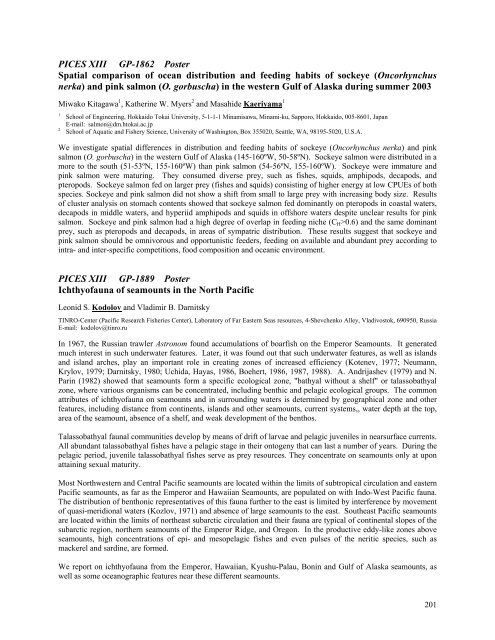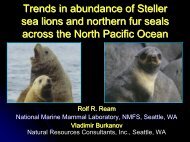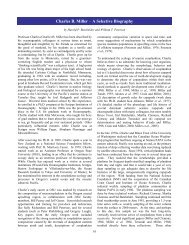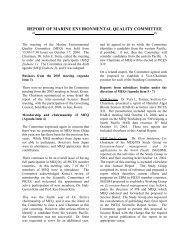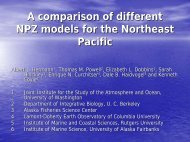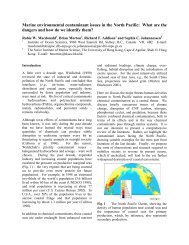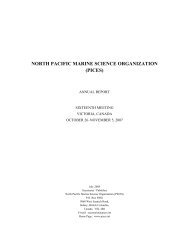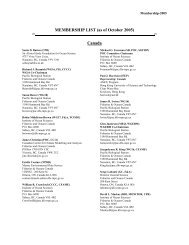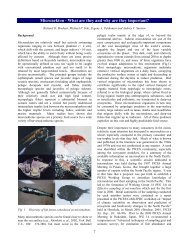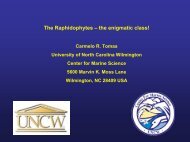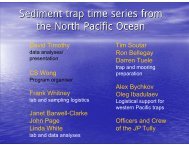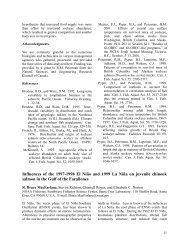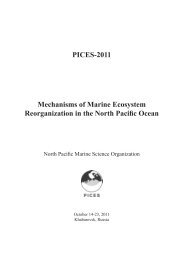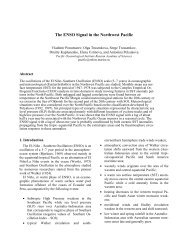<strong>PICES</strong> XIII GP-1799 PosterStock enhancement policy for Japanese red sea bream, Pagrus major, by release ofjuveniles and fisheries managementToyomitsu Horii 1 and Hiromu Zenitani 212Yokosuka Branch of National Research Institute of Fisheries Science, Fisheries Research Agency, 6-31-1 Nagai, Yokosuka 238-0316, JapanE-mail: thorii@affrc.go.jpNational Research Institute of Fisheries and Environment of Inland Sea, Fisheries Research Agency, 2-17-5 Maruishi, Ohno, Saeki, Hiroshima739-0452, JapanJapanese red sea bream is a major target of commercial and recreational fishing, and millions of juveniles have beenreleased each year for stock enhancement since the early 1980s. Recovery rates and expected catches of releasedjuveniles were estimated to be 5-17% and 20-80 tons per million juveniles, respectively, in the case of the southerncoastal area. In this paper, the effects of juvenile release on the sustainable yield from two local stocks, the southerncoastal area and the Seto inland sea area, were evaluated.Numbers of recruits and brood stock biomass during 1983-1993 were estimated with virtual population analysis(VPA) from data of age composition of landed fish. When the relationships between brood stock biomass andrecruits followed the Ricker model, number of 1-year-old recruits in t year (R t ) wasR t = A * E t-1 * exp( -B * E t-1 ) + S t-1 * KHere, A and B are the parameters of the Ricker model curve, and E t is brood stock biomass. S t and K are numbersof released juveniles and the survival rate of released juveniles until becoming 1-year-olds, respectively. A, B and Kwere estimated by the method of least squares. Using these parameters, the relationships among fishing mortality,number of releases and sustainable yield were calculated.The increments of sustainable yield by stocking were estimated to be 20% and 2% in the two local stocks of thesouthern coastal area and the Seto Inland Sea area, respectively, under the current status of fishing mortality andnumber of released juveniles. Differences in increments were caused by differences in stocking impact and fishingmortality. The adequacy of the enhancement policy on the two local stocks is discussed.<strong>PICES</strong> XIII GP-2077 PosterUsing a generalized additive model to predict Bigeye (Thunnus obesus) CPUE at thePalmyra fishing groundsEvan A. Howell and Donald R. KobayashiPacific Islands Fisheries Science Center, National Marine Fisheries Service, NOAA, 2570 Dole Street, Honolulu, HI, 96822-2396, U.S.A.E-mail: Evan.Howell@noaa.govThe fishing grounds around the Palmyra Atoll can account for up to 20% of bigeye and over 55% of yellowfin tunalanded in the Hawaii Long-line Fishery since 1994. The observed availability of these two species of tuna appearsto fluctuate based on environmental conditions, with catches around Palmyra dominated by yellowfin tuna, except inyears of El Niño events. This variability in catch, when compounded with the travel time and cost for Hawaiianvessels, diminishes the desire to fish these productive waters. Modeling techniques were employed to attempt todecipher which parameters are important in determining the catch composition and to produce a basic prediction ofthe magnitude of bigeye catch. Generalized additive models (GAM) were used within a k-fold cross-validationframework to construct a predictive model of bigeye tuna (Thunnus obesus) catch rate on long-line fishing geararound Palmyra Atoll. This approach was contrasted with commonly used stepwise model construction techniquesto examine the effects of overfitting. Preliminary results revealed that two environmental parameters with date andlocations were sufficient to account for close to 70% of the bigeye CPUE. The main environmental parameterrequired by the model was an ecosystem indicator derived from an empirical orthogonal analysis (EOF) of altimetrydata in the Pacific equatorial region. A parsimonious model using several predictor variables was also constructedand found to be satisfactory for predicting long-line fishing success.200
<strong>PICES</strong> XIII GP-1862 PosterSpatial comparison of ocean distribution and feeding habits of sockeye (Oncorhynchusnerka) and pink salmon (O. gorbuscha) in the western Gulf of Alaska during summer 2003Miwako Kitagawa 1 , Katherine W. Myers 2 and Masahide Kaeriyama 112School of Engineering, Hokkaido Tokai University, 5-1-1-1 Minamisawa, Minami-ku, Sapporo, Hokkaido, 005-8601, JapanE-mail: salmon@dm.htokai.ac.jpSchool of Aquatic and Fishery Science, University of Washington, Box 355020, Seattle, WA, 98195-5020, U.S.A.We investigate spatial differences in distribution and feeding habits of sockeye (Oncorhynchus nerka) and pinksalmon (O. gorbuscha) in the western Gulf of Alaska (145-160ºW, 50-58ºN). Sockeye salmon were distributed in amore to the south (51-53ºN, 155-160ºW) than pink salmon (54-56ºN, 155-160ºW). Sockeye were immature andpink salmon were maturing. They consumed diverse prey, such as fishes, squids, amphipods, decapods, andpteropods. Sockeye salmon fed on larger prey (fishes and squids) consisting of higher energy at low CPUEs of bothspecies. Sockeye and pink salmon did not show a shift from small to large prey with increasing body size. Resultsof cluster analysis on stomach contents showed that sockeye salmon fed dominantly on pteropods in coastal waters,decapods in middle waters, and hyperiid amphipods and squids in offshore waters despite unclear results for pinksalmon. Sockeye and pink salmon had a high degree of overlap in feeding niche (C H >0.6) and the same dominantprey, such as pteropods and decapods, in areas of sympatric distribution. These results suggest that sockeye andpink salmon should be omnivorous and opportunistic feeders, feeding on available and abundant prey according tointra- and inter-specific competitions, food composition and oceanic environment.<strong>PICES</strong> XIII GP-1889 PosterIchthyofauna of seamounts in the North PacificLeonid S. Kodolov and Vladimir B. DarnitskyTINRO-Center (Pacific Research Fisheries Center), Laboratory of Far Eastern Seas resources, 4-Shevchenko Alley, Vladivostok, 690950, RussiaE-mail: kodolov@tinro.ruIn 1967, the Russian trawler Astronom found accumulations of boarfish on the Emperor Seamounts. It generatedmuch interest in such underwater features. Later, it was found out that such underwater features, as well as islandsand island arches, play an important role in creating zones of increased efficiency (Kotenev, 1977; Neumann,Krylov, 1979; Darnitsky, 1980; Uchida, Hayas, 1986, Boehert, 1986, 1987, 1988). A. Andrijashev (1979) and N.Parin (1982) showed that seamounts form a specific ecological zone, "bathyal without a shelf" or talassobathyalzone, where various organisms can be concentrated, including benthic and pelagic ecological groups. The commonattributes of ichthyofauna on seamounts and in surrounding waters is determined by geographical zone and otherfeatures, including distance from continents, islands and other seamounts, current systems,, water depth at the top,area of the seamount, absence of a shelf, and weak development of the benthos.Talassobathyal faunal communities develop by means of drift of larvae and pelagic juveniles in nearsurface currents.All abundant talassobathyal fishes have a pelagic stage in their ontogeny that can last a number of years. During thepelagic period, juvenile talassobathyal fishes serve as prey resources. They concentrate on seamounts only at uponattaining sexual maturity.Most Northwestern and Central Pacific seamounts are located within the limits of subtropical circulation and easternPacific seamounts, as far as the Emperor and Hawaiian Seamounts, are populated on with Indo-West Pacific fauna.The distribution of benthonic representatives of this fauna further to the east is limited by interference by movementof quasi-meridional waters (Kozlov, 1971) and absence of large seamounts to the east. Southeast Pacific seamountsare located within the limits of northeast subarctic circulation and their fauna are typical of continental slopes of thesubarctic region, northern seamounts of the Emperor Ridge, and Oregon. In the productive eddy-like zones aboveseamounts, high concentrations of epi- and mesopelagic fishes and even pulses of the neritic species, such asmackerel and sardine, are formed.We report on ichthyofauna from the Emperor, Hawaiian, Kyushu-Palau, Bonin and Gulf of Alaska seamounts, aswell as some oceanographic features near these different seamounts.201
- Page 3:
Keynote AddressPICES XIIISend out t
- Page 8 and 9:
14:50-15:10 Coffee break15:10-15:30
- Page 10 and 11:
PICES XIII S1-1827 PosterThe red fl
- Page 12 and 13:
PICES XIII S1-2018 InvitedRelation
- Page 14 and 15:
PICES XIII S1-2049 InvitedZooplankt
- Page 16 and 17:
forage base while physical gradient
- Page 19 and 20:
S2BIO Topic SessionMechanisms that
- Page 21:
09:20-09:40 Rubén Rodríguez-Sánc
- Page 24 and 25:
PICES XIII S2-1852 OralMechanisms o
- Page 26 and 27:
PICES XIII S2-2003 OralTop-down mod
- Page 28 and 29:
PICES XIII S2-2116 OralWhen, where
- Page 30 and 31:
espectively, several lines of evide
- Page 32 and 33:
PICES XIII S2-1939 InvitedWhy do om
- Page 34 and 35:
ased on optimal temperatures for la
- Page 37 and 38:
S3BIO Topic SessionRole of gelatino
- Page 39 and 40:
PICES XIII S3-1824 OralPredation on
- Page 41 and 42:
PICES XIII S3-1908 PosterSeasonal d
- Page 43 and 44:
stable-isotope ratios of carbon and
- Page 45 and 46:
PICES XIII S3-1930 OralA comparison
- Page 47 and 48:
S4FIS/BIO Topic SessionHot spots an
- Page 49:
17:00-17:20 Vincent F. Gallucci and
- Page 52 and 53:
PICES XIII S4-1983 OralExistence of
- Page 54 and 55:
the coast to 200 km offshore. More
- Page 56 and 57:
PICES XIII S4-1913 InvitedHow to di
- Page 58 and 59:
PICES XIII S4-2046 OralIdentifying
- Page 60 and 61:
PICES XIII S4-2097 InvitedAn oceano
- Page 62 and 63:
PICES XIII S4-1797 PosterZone of
- Page 65 and 66:
S5MEQ Topic SessionIntroductions of
- Page 67 and 68:
PICES XIII S5-1777 OralAnthropogeni
- Page 69 and 70:
PICES XIII S5-2178 OralThe Ballast
- Page 71 and 72:
Pseudo-nitzschia, causative organis
- Page 73:
PICES XIII S5-2139 OralIntroduced s
- Page 77 and 78:
PICES XIII S6-2203 OralMethods for
- Page 79 and 80:
PICES XIII S6-2104 PosterEcologic a
- Page 81 and 82:
S7POC/MONITOR Topic SessionApplicat
- Page 83:
PostersYury N. Volkov, Igor E. Koch
- Page 86 and 87:
PICES XIII S7-1801 OralEl Niño phe
- Page 88 and 89:
PICES XIII S7-2189 PosterMain effec
- Page 90 and 91:
PICES XIII S7-2090 PosterNorth Paci
- Page 92 and 93:
PICES XIII S7-1861 PosterSatellite
- Page 94 and 95:
almost constant over the whole year
- Page 96 and 97:
overestimation of chl-a in the Beri
- Page 98 and 99:
PICES XIII S7-2196 PosterInterannua
- Page 101 and 102:
S8POC Topic SessionThe impacts of c
- Page 103:
PostersAndrey G. Andreev and Viktor
- Page 106 and 107:
the Pacific Ocean. Analyses of the
- Page 108 and 109:
PICES XIII S8-1834 OralAttributing
- Page 110 and 111:
will report results of a workshop c
- Page 112 and 113:
PICES XIII S8-2047 InvitedMicrobial
- Page 114 and 115:
PICES XIII S8-2140 OralInterannual
- Page 116 and 117:
salinity showed similar distributio
- Page 119 and 120:
S9CCCC Topic SessionThe impacts of
- Page 121 and 122:
13:50-14:10 Randall M. Peterman, Br
- Page 123 and 124:
PICES XIII S9-1900 OralComparison o
- Page 125 and 126:
PICES XIII S9-1931 OralU.S. GLOBEC:
- Page 127 and 128:
PICES XIII S9-1807 OralDid regime s
- Page 129 and 130:
depth ranges are computed for summe
- Page 131 and 132:
PICES XIII S9-2131 OralA new intern
- Page 133 and 134:
PICES XIII S9-1894 OralThe latitudi
- Page 135 and 136:
Southern Oscillation Index) were of
- Page 137 and 138:
PICES XIII S9-1789 OralPopulation d
- Page 139 and 140:
PICES XIII S9-2076 OralProgresses a
- Page 141 and 142:
PICES XIII S9-2108 OralThe importan
- Page 143 and 144:
PICES XIII S9-1968 OralInterannual
- Page 145:
PICES XIII S9-1871 OralChanging oce
- Page 148 and 149:
PostersIrina V. IshmukovaAssessing
- Page 150 and 151:
PICES XIII S10-2041 OralQuantifying
- Page 152 and 153:
PICES XIII S10-2083 PosterModeling
- Page 154 and 155:
phytoplankton growth throughout the
- Page 157 and 158: PICES XIII S11-1806 E-posterResearc
- Page 159 and 160: PICES XIII S11-1975 E-posterDevelop
- Page 161: cyclonic eddy field and then moved
- Page 164 and 165: Eun Seob ChoPCR-based assays for de
- Page 166 and 167: PICES XIII BIO_P-1980 PosterPCR-bas
- Page 168 and 169: marine organisms. Acoustic methods
- Page 170 and 171: the total copepod biomass through t
- Page 172 and 173: PICES XIII BIO_P-1770 PosterCommuni
- Page 174 and 175: 16:05-16:20 Andre Buchheister and M
- Page 177 and 178: PICES XIII FIS_P-1814 PosterModelin
- Page 179 and 180: around the islands. In 1993, there
- Page 181 and 182: coefficient. The model comparison u
- Page 183 and 184: central region of the Bungo Channel
- Page 185 and 186: PICES XIII FIS_P-1950 PosterDensity
- Page 187 and 188: PICES XIII FIS_P-1995 OralInterannu
- Page 189 and 190: variability in age class structure
- Page 191 and 192: PICES XIII FIS_P-1957 OralGeographi
- Page 193 and 194: PICES XIII FIS_P-1831 PosterGrowth
- Page 195 and 196: General Poster SessionWednesday, Oc
- Page 197: Nina I. Savelieva, Vladimir I. Pono
- Page 200 and 201: PICES XIII GP-1962 PosterNew compre
- Page 202 and 203: PICES XIII GP-2019 PosterMultiyear
- Page 204 and 205: PICES XIII GP-1839 PosterDeath of t
- Page 208 and 209: PICES XIII GP-1891 PosterSeamounts
- Page 210 and 211: PICES XIII GP-1905 PosterBiomarkers
- Page 212 and 213: etween 170˚E and 166˚W. In most c
- Page 214 and 215: ottom layers because of denitrifica
- Page 216 and 217: has increased. But in the Norwegian
- Page 218 and 219: PICES XIII GP-1841 PosterHorizontal
- Page 221: W1MIE-AP Workshop and Advisory Pane
- Page 224 and 225: 11:45-12:10 Hyun-Cheol Kim, Sinjae
- Page 226 and 227: PICES XIII W2-1932 PosterGrowth rat
- Page 228 and 229: Copepods were abundant in April and
- Page 230 and 231: PICES XIII W2-2082 OralSeasonal cyc
- Page 233 and 234: W3CCCC WorkshopLinking open ocean a
- Page 235 and 236: PICES XIII W3-2004 InvitedModeling
- Page 237 and 238: characteristic cyclic relationship.
- Page 239 and 240: W4PICES/CLIVAR WorkshopScale intera
- Page 241: 13:30-14:15 Richard A. Feely, C. L.
- Page 244 and 245: PICES XIII W4-1984 InvitedCLIVAR/CO
- Page 246 and 247: PICES XIII W4-1992 InvitedThe impac
- Page 248 and 249: PICES XIII W4-2155 InvitedGlobal li
- Page 250 and 251: the subtropic Northwest Pacific and
- Page 252 and 253: Environmental changes at inter-annu
- Page 254 and 255: 14:30-15:00 Discussion of usefulnes
- Page 257 and 258:
W5 Workshop AbstractsPICES XIII W5-
- Page 259 and 260:
PICES XIII W5-2193 OralUse of Korea
- Page 261 and 262:
HAB Meeting AbstractsPICES XIII HAB
- Page 263 and 264:
PICES XIII HAB-2039 OralThe use of
- Page 265:
W6MBM-AP WorkshopCombining data set
- Page 268 and 269:
PICES XIII W6-1973 OralDistribution
- Page 271 and 272:
Index of AuthorsPresenter Name: Pap
- Page 273 and 274:
DDagg, Michael S3-1979 p.33Daly, El
- Page 275 and 276:
IIanson, Debby S8-2147 p.104Ichihar
- Page 277 and 278:
Kruse, Gordon H. FIS_P-1873 p.182S2
- Page 279 and 280:
Nagasawa, Toru FIS_P-1922 p.175Naka
- Page 281 and 282:
Samko, Eugene V. S4-1815 p.53Samuel
- Page 283 and 284:
Vinnikov, Andrey V. FIS_P-2088 p.18
- Page 285:
PICES AcronymsAP Advisory PanelAPN


